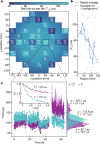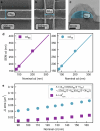Advanced CMOS manufacturing of superconducting qubits on 300 mm wafers
- PMID: 39294381
- PMCID: PMC11446867
- DOI: 10.1038/s41586-024-07941-9
Advanced CMOS manufacturing of superconducting qubits on 300 mm wafers
Abstract
The development of superconducting qubit technology has shown great potential for the construction of practical quantum computers1,2. As the complexity of quantum processors continues to grow, the need for stringent fabrication tolerances becomes increasingly critical3. Utilizing advanced industrial fabrication processes could facilitate the necessary level of fabrication control to support the continued scaling of quantum processors. However, at present, these industrial processes are not optimized to produce high-coherence devices, nor are they a priori compatible with the approaches commonly used to make superconducting qubits. Here we demonstrate superconducting transmon qubits manufactured in a 300 mm complementary metal-oxide-semiconductor (CMOS) pilot line using industrial fabrication methods, with resulting relaxation and coherence times exceeding 100 μs. We show across-wafer, large-scale statistics of coherence, yield, variability and ageing that confirm the validity of our approach. The presented industry-scale fabrication process, which uses only optical lithography and reactive-ion etching, has a performance and yield in line with conventional laboratory-style techniques utilizing metal lift-off, angled evaporation and electron-beam writing4. Moreover, it offers the potential for further upscaling through three-dimensional integration5 and more process optimization. This result marks the advent of an alternative and new, large-scale, truly CMOS-compatible fabrication method for superconducting quantum computing processors.
© 2024. The Author(s).
Conflict of interest statement
The authors declare no competing interests.
Figures








References
-
- Arute, F. et al. Quantum supremacy using a programmable superconducting processor. Nature574, 505–510 (2019). - PubMed
-
- Osman, A. et al. Mitigation of frequency collisions in superconducting quantum processors. Phys. Rev. Res.5, 043001 (2023).
-
- de Leon, N. P. et al. Materials challenges and opportunities for quantum computing hardware. Science372, eabb2823 (2021). - PubMed
-
- Kosen, S. et al. Building blocks of a flip-chip integrated superconducting quantum processor. Quantum Sci. Technol.7, 035018 (2022).
LinkOut - more resources
Full Text Sources
Research Materials

